charging TOYOTA YARIS 2014 User Guide
[x] Cancel search | Manufacturer: TOYOTA, Model Year: 2014, Model line: YARIS, Model: TOYOTA YARIS 2014Pages: 712, PDF Size: 30.2 MB
Page 562 of 712
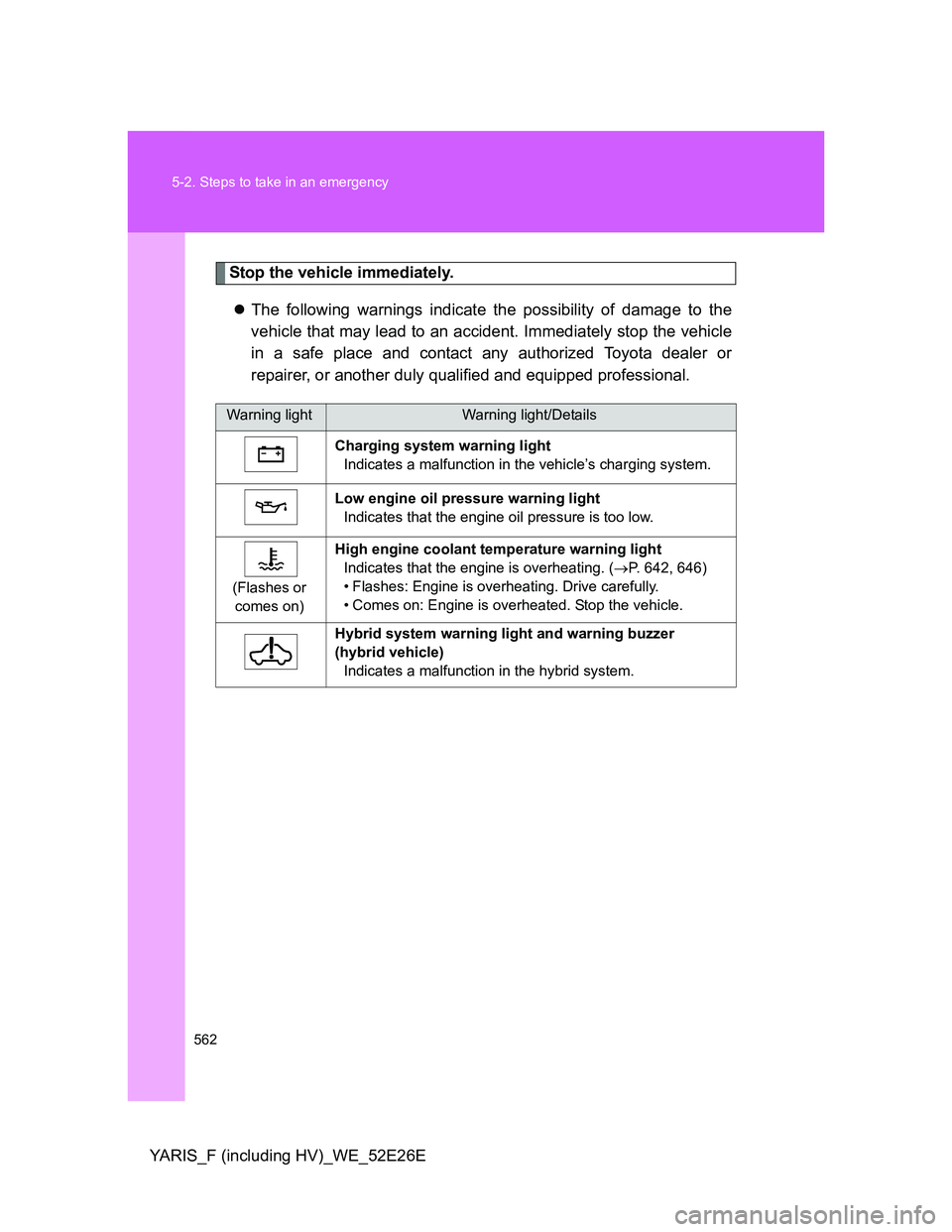
562 5-2. Steps to take in an emergency
YARIS_F (including HV)_WE_52E26E
Stop the vehicle immediately.
The following warnings indicate the possibility of damage to the
vehicle that may lead to an accident. Immediately stop the vehicle
in a safe place and contact any authorized Toyota dealer or
repairer, or another duly qualified and equipped professional.
Warning lightWarning light/Details
Charging system warning light
Indicates a malfunction in the vehicle’s charging system.
Low engine oil pressure warning light
Indicates that the engine oil pressure is too low.
(Flashes or
comes on)High engine coolant temperature warning light
Indicates that the engine is overheating. (P. 642, 646)
• Flashes: Engine is overheating. Drive carefully.
• Comes on: Engine is overheated. Stop the vehicle.
Hybrid system warning light and warning buzzer
(hybrid vehicle)
Indicates a malfunction in the hybrid system.
Page 633 of 712
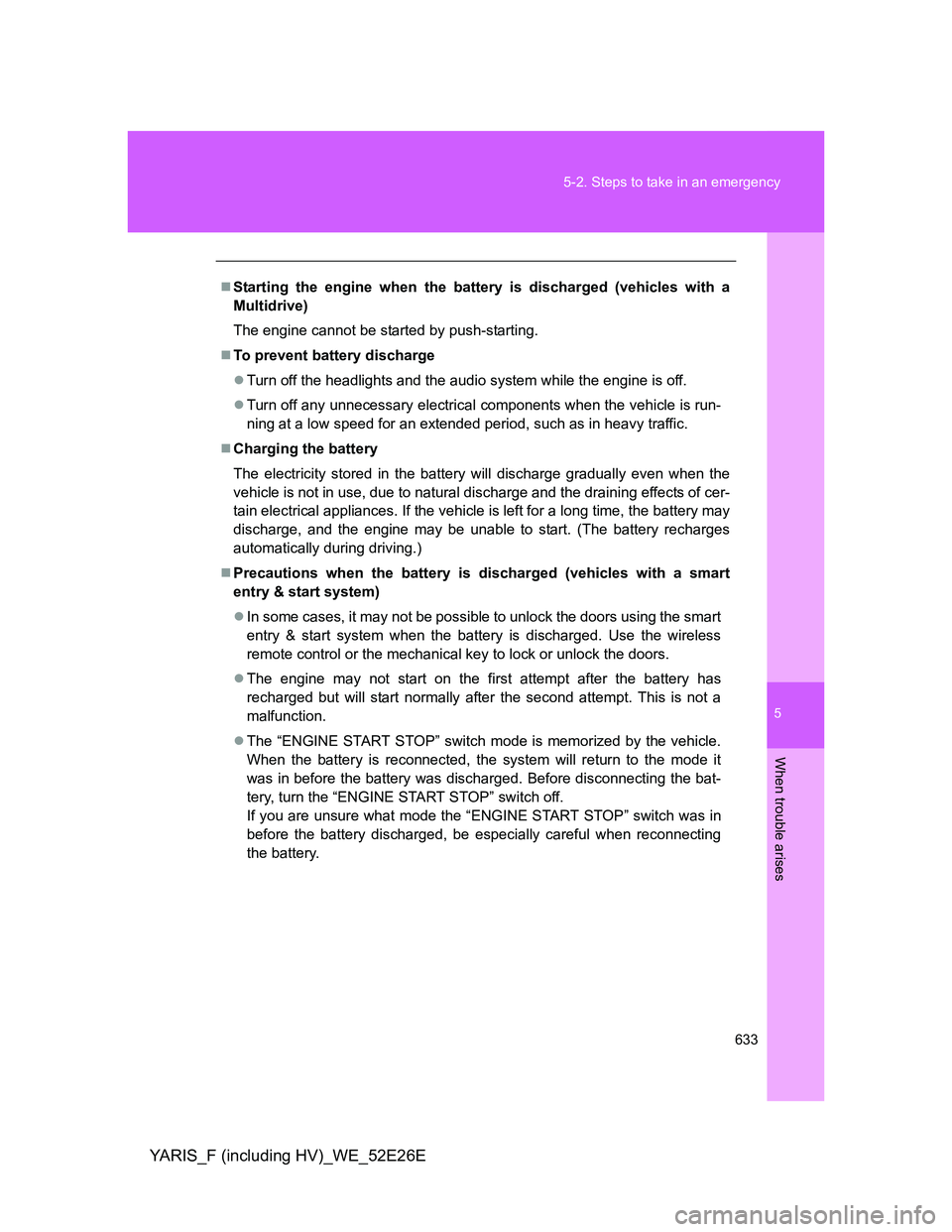
5
633 5-2. Steps to take in an emergency
When trouble arises
YARIS_F (including HV)_WE_52E26E
Starting the engine when the battery is discharged (vehicles with a
Multidrive)
The engine cannot be started by push-starting.
To prevent battery discharge
Turn off the headlights and the audio system while the engine is off.
Turn off any unnecessary electrical components when the vehicle is run-
ning at a low speed for an extended period, such as in heavy traffic.
Charging the battery
The electricity stored in the battery will discharge gradually even when the
vehicle is not in use, due to natural discharge and the draining effects of cer-
tain electrical appliances. If the vehicle is left for a long time, the battery may
discharge, and the engine may be unable to start. (The battery recharges
automatically during driving.)
Precautions when the battery is discharged (vehicles with a smart
entry & start system)
In some cases, it may not be possible to unlock the doors using the smart
entry & start system when the battery is discharged. Use the wireless
remote control or the mechanical key to lock or unlock the doors.
The engine may not start on the first attempt after the battery has
recharged but will start normally after the second attempt. This is not a
malfunction.
The “ENGINE START STOP” switch mode is memorized by the vehicle.
When the battery is reconnected, the system will return to the mode it
was in before the battery was discharged. Before disconnecting the bat-
tery, turn the “ENGINE START STOP” switch off.
If you are unsure what mode the “ENGINE START STOP” switch was in
before the battery discharged, be especially careful when reconnecting
the battery.
Page 639 of 712
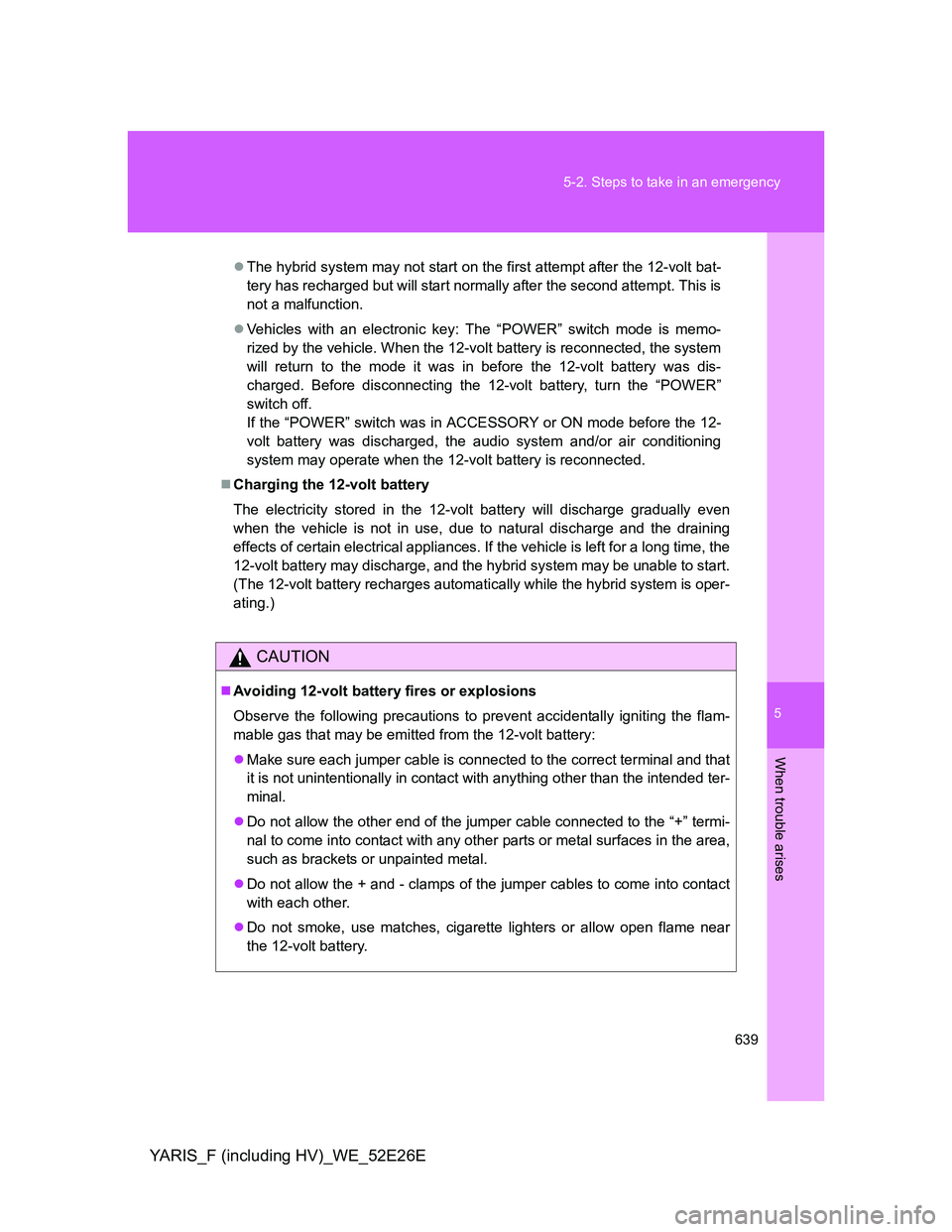
5
639 5-2. Steps to take in an emergency
When trouble arises
YARIS_F (including HV)_WE_52E26E
The hybrid system may not start on the first attempt after the 12-volt bat-
tery has recharged but will start normally after the second attempt. This is
not a malfunction.
Vehicles with an electronic key: The “POWER” switch mode is memo-
rized by the vehicle. When the 12-volt battery is reconnected, the system
will return to the mode it was in before the 12-volt battery was dis-
charged. Before disconnecting the 12-volt battery, turn the “POWER”
switch off.
If the “POWER” switch was in ACCESSORY or ON mode before the 12-
volt battery was discharged, the audio system and/or air conditioning
system may operate when the 12-volt battery is reconnected.
Charging the 12-volt battery
The electricity stored in the 12-volt battery will discharge gradually even
when the vehicle is not in use, due to natural discharge and the draining
effects of certain electrical appliances. If the vehicle is left for a long time, the
12-volt battery may discharge, and the hybrid system may be unable to start.
(The 12-volt battery recharges automatically while the hybrid system is oper-
ating.)
CAUTION
Avoiding 12-volt battery fires or explosions
Observe the following precautions to prevent accidentally igniting the flam-
mable gas that may be emitted from the 12-volt battery:
Make sure each jumper cable is connected to the correct terminal and that
it is not unintentionally in contact with anything other than the intended ter-
minal.
Do not allow the other end of the jumper cable connected to the “+” termi-
nal to come into contact with any other parts or metal surfaces in the area,
such as brackets or unpainted metal.
Do not allow the + and - clamps of the jumper cables to come into contact
with each other.
Do not smoke, use matches, cigarette lighters or allow open flame near
the 12-volt battery.
Page 640 of 712

640 5-2. Steps to take in an emergency
YARIS_F (including HV)_WE_52E26E
CAUTION
After recharging the 12-volt battery
Have the 12-volt battery inspected at any authorized Toyota dealer or
repairer, or another duly qualified and equipped professional as soon as
possible.
If the 12-volt battery is deteriorating, continued use may cause the 12-volt
battery to emit a malodorous gas, which may be detrimental to the health of
passengers.
When replacing the 12-volt battery
P. 489
12-volt battery precautions
The 12-volt battery contains poisonous and corrosive acidic electrolyte,
while related parts contain lead and lead compounds. Observe the following
precautions when handling the 12-volt battery:
When working with the 12-volt battery, always wear safety glasses and
take care not to allow any battery fluids (acid) to come into contact with
skin, clothing or the vehicle body.
Do not lean over the 12-volt battery.
In the event that battery fluid comes into contact with the skin or eyes,
immediately wash the affected area with water and seek medical attention.
Place a wet sponge or cloth over the affected area until medical attention
can be received.
Always wash your hands after handling the battery support, terminals, and
other battery-related parts.
Do not allow children near the 12-volt battery.
Page 641 of 712
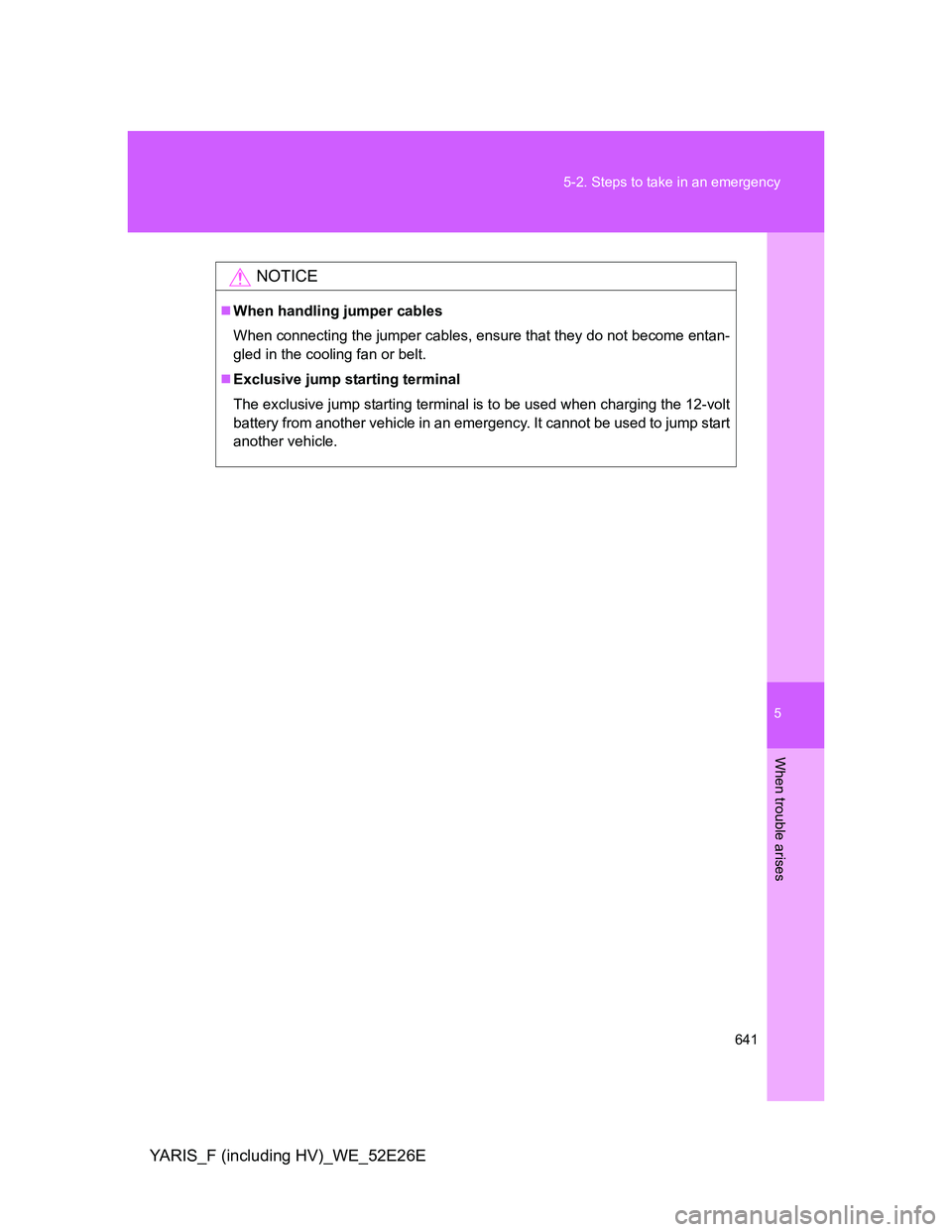
5
641 5-2. Steps to take in an emergency
When trouble arises
YARIS_F (including HV)_WE_52E26E
NOTICE
When handling jumper cables
When connecting the jumper cables, ensure that they do not become entan-
gled in the cooling fan or belt.
Exclusive jump starting terminal
The exclusive jump starting terminal is to be used when charging the 12-volt
battery from another vehicle in an emergency. It cannot be used to jump start
another vehicle.
Page 675 of 712
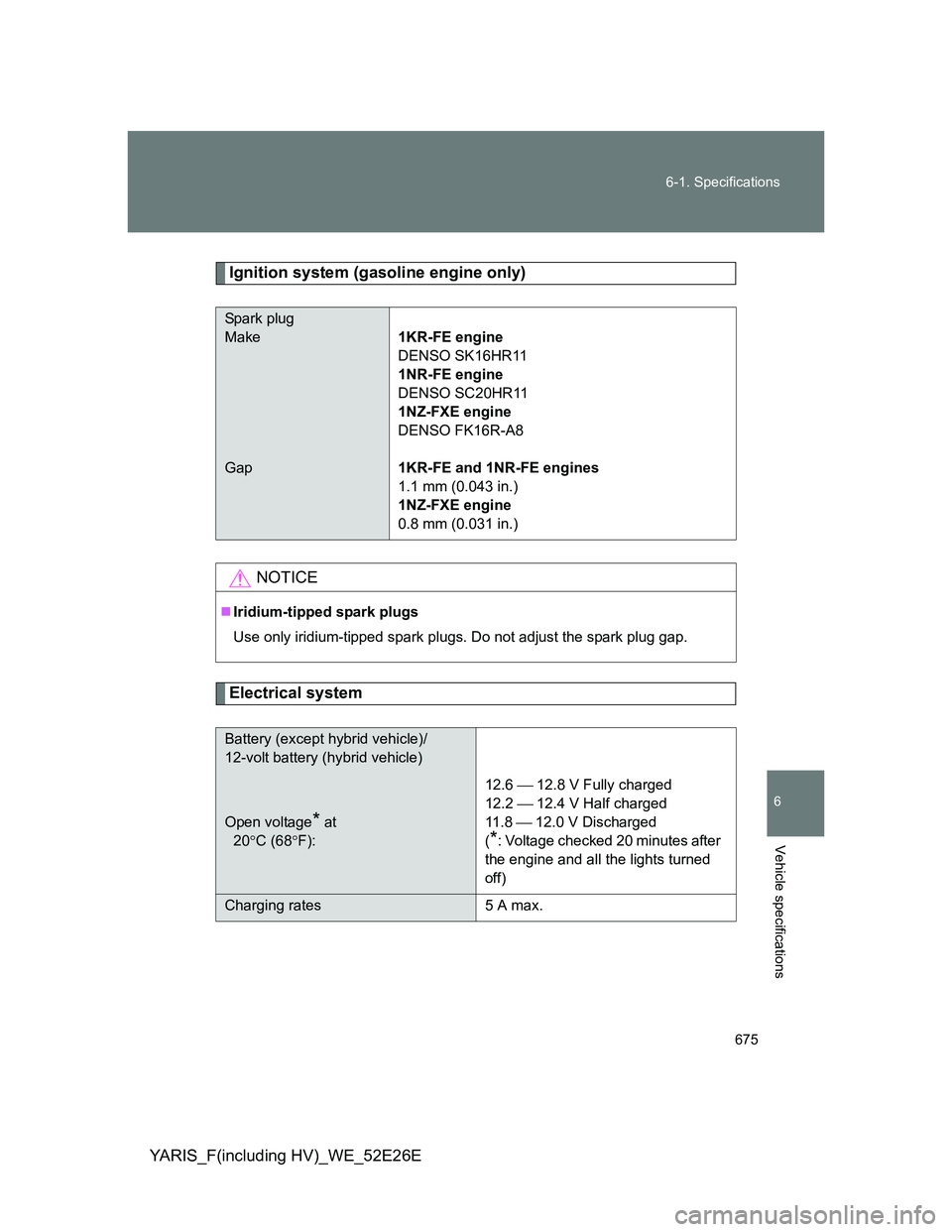
675 6-1. Specifications
6
Vehicle specifications
YARIS_F(including HV)_WE_52E26E
Ignition system (gasoline engine only)
Electrical system
Spark plug
Make
Gap1KR-FE engine
DENSO SK16HR11
1NR-FE engine
DENSO SC20HR11
1NZ-FXE engine
DENSO FK16R-A8
1KR-FE and 1NR-FE engines
1.1 mm (0.043 in.)
1NZ-FXE engine
0.8 mm (0.031 in.)
NOTICE
Iridium-tipped spark plugs
Use only iridium-tipped spark plugs. Do not adjust the spark plug gap.
Battery (except hybrid vehicle)/
12-volt battery (hybrid vehicle)
Open voltage* at
20C (68F):12.6 12.8 V Fully charged
12.2 12.4 V Half charged
11 . 8 12.0 V Discharged
(
*: Voltage checked 20 minutes after
the engine and all the lights turned
off)
Charging rates 5 A max.
Page 703 of 712
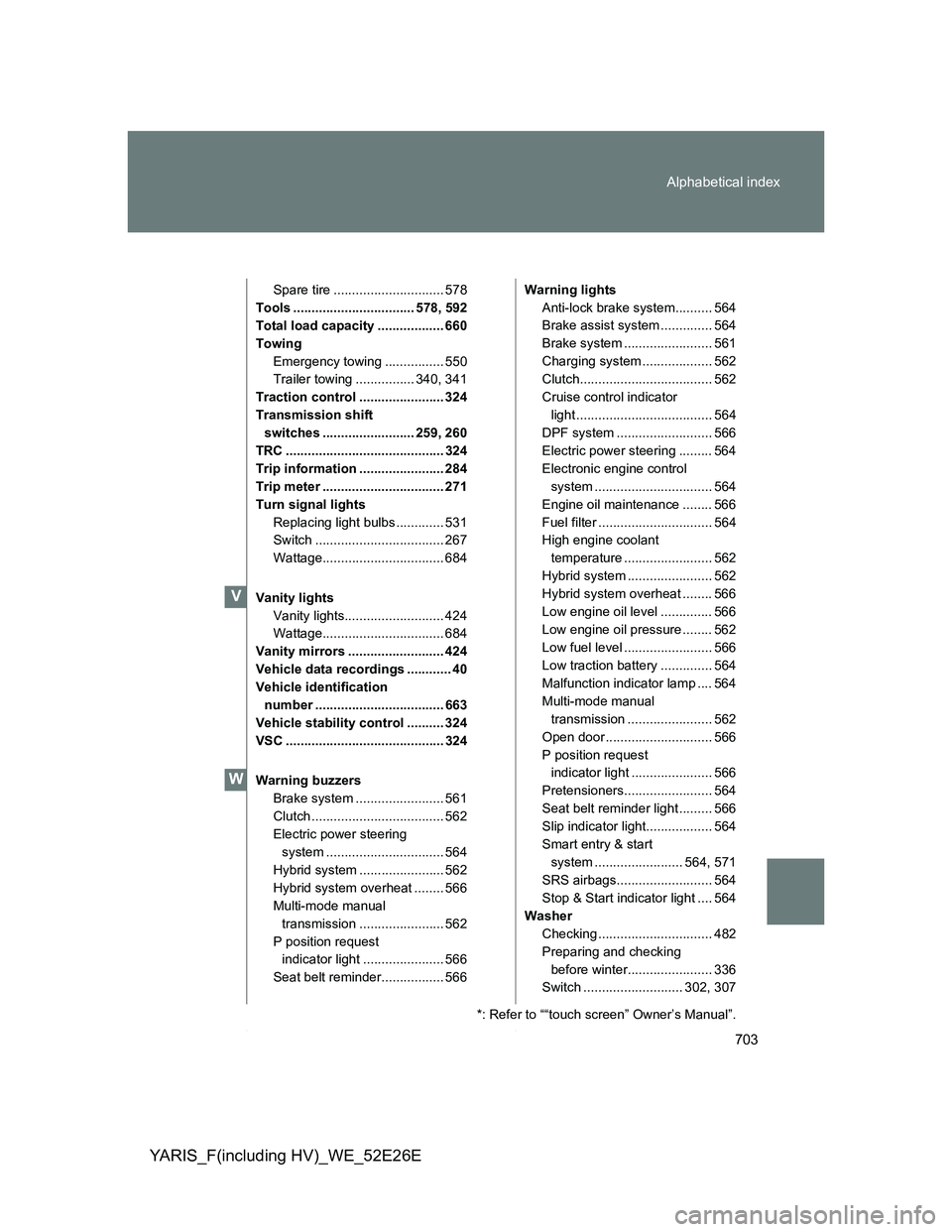
703 Alphabetical index
YARIS_F(including HV)_WE_52E26E
Spare tire .............................. 578
Tools ................................. 578, 592
Total load capacity .................. 660
Towing
Emergency towing ................ 550
Trailer towing ................ 340, 341
Traction control ....................... 324
Transmission shift
switches ......................... 259, 260
TRC ........................................... 324
Trip information ....................... 284
Trip meter ................................. 271
Turn signal lights
Replacing light bulbs ............. 531
Switch ................................... 267
Wattage................................. 684
Vanity lights
Vanity lights........................... 424
Wattage................................. 684
Vanity mirrors .......................... 424
Vehicle data recordings ............ 40
Vehicle identification
number ................................... 663
Vehicle stability control .......... 324
VSC ........................................... 324
Warning buzzers
Brake system ........................ 561
Clutch .................................... 562
Electric power steering
system ................................ 564
Hybrid system ....................... 562
Hybrid system overheat ........ 566
Multi-mode manual
transmission ....................... 562
P position request
indicator light ...................... 566
Seat belt reminder................. 566Warning lights
Anti-lock brake system.......... 564
Brake assist system .............. 564
Brake system ........................ 561
Charging system ................... 562
Clutch.................................... 562
Cruise control indicator
light ..................................... 564
DPF system .......................... 566
Electric power steering ......... 564
Electronic engine control
system ................................ 564
Engine oil maintenance ........ 566
Fuel filter ............................... 564
High engine coolant
temperature ........................ 562
Hybrid system ....................... 562
Hybrid system overheat ........ 566
Low engine oil level .............. 566
Low engine oil pressure ........ 562
Low fuel level ........................ 566
Low traction battery .............. 564
Malfunction indicator lamp .... 564
Multi-mode manual
transmission ....................... 562
Open door ............................. 566
P position request
indicator light ...................... 566
Pretensioners........................ 564
Seat belt reminder light ......... 566
Slip indicator light.................. 564
Smart entry & start
system ........................ 564, 571
SRS airbags.......................... 564
Stop & Start indicator light .... 564
Washer
Checking ............................... 482
Preparing and checking
before winter....................... 336
Switch ........................... 302, 307
V
*: Refer to ““touch screen” Owner’s Manual”.
W
Page 709 of 712
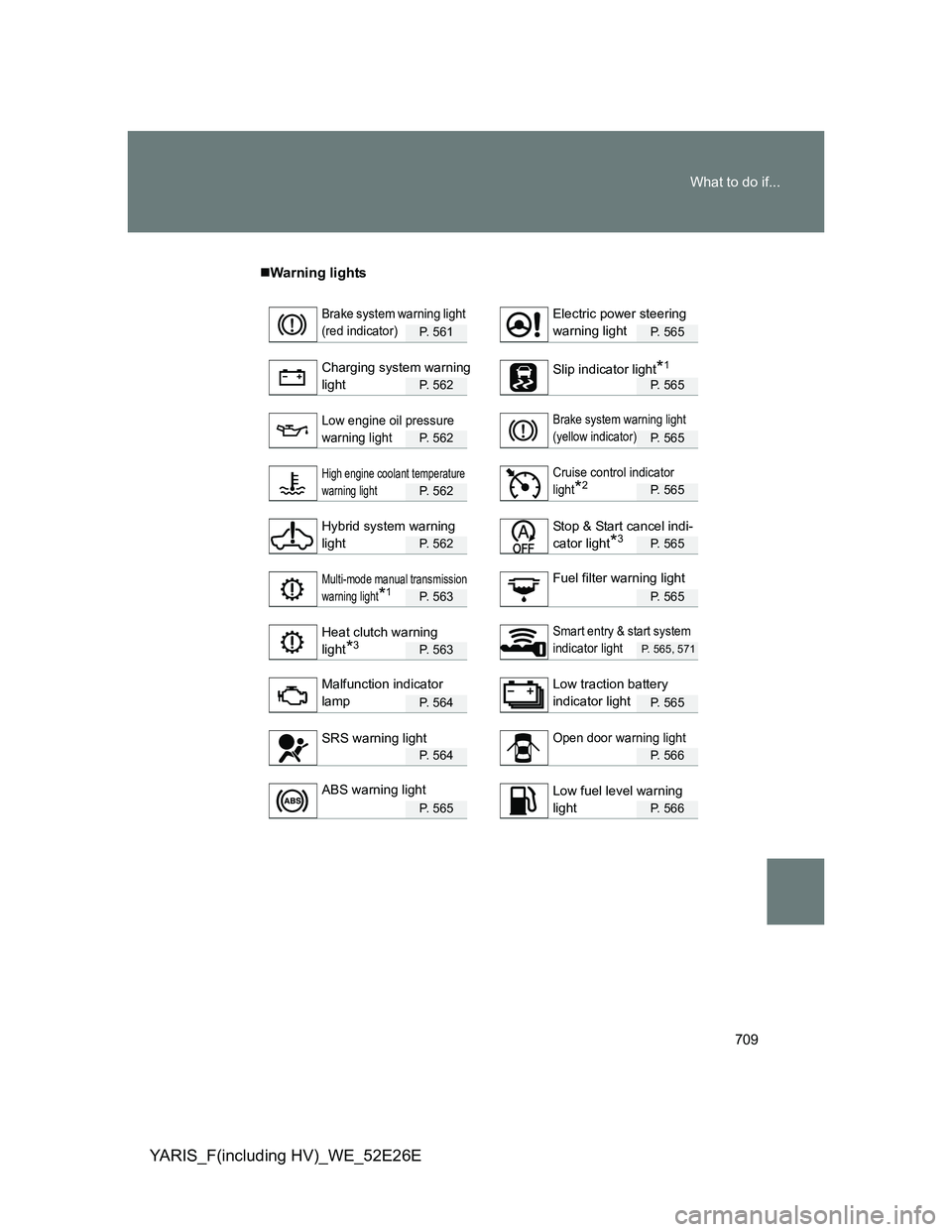
709 What to do if...
YARIS_F(including HV)_WE_52E26E
Warning lights
P. 5 6 1P. 565
P. 5 6 2P. 565
P. 5 6 2P. 565
P. 5 6 2P. 565
P. 5 6 2P. 565
P. 5 6 3P. 565
P. 5 6 3P. 565, 571
P. 5 6 4P. 565
P. 5 6 4P. 566
P. 5 6 5P. 566
Brake system warning light
(red indicator)Electric power steering
warning light
Charging system warning
lightSlip indicator light*1
Low engine oil pressure
warning lightBrake system warning light
(yellow indicator)
High engine coolant temperature
warning lightCruise control indicator
light
*2
Hybrid system warning
lightStop & Start cancel indi-
cator light
*3
Multi-mode manual transmission
warning light
*1Fuel filter warning light
Heat clutch warning
light
*3Smart entry & start system
indicator light
Malfunction indicator
lampLow traction battery
indicator light
SRS warning lightOpen door warning light
ABS warning lightLow fuel level warning
light